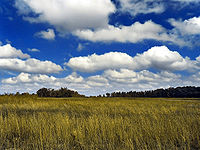
Photo from wikipedia
Limited area cloud‐resolving model (CRM) simulations called LASAM are used to reproduce and understand negative subtropical shallow cumulus cloud feedbacks in a near‐global aquaplanet CRM (NGAqua) with 4‐K sea surface… Click to show full abstract
Limited area cloud‐resolving model (CRM) simulations called LASAM are used to reproduce and understand negative subtropical shallow cumulus cloud feedbacks in a near‐global aquaplanet CRM (NGAqua) with 4‐K sea surface temperature (SST) warming. NGAqua spans a large tropical channel domain, with 4‐km horizontal resolution, zonally symmetric equatorially peaked SST, and no cumulus parameterization. Prior work showed that its coarsely resolved shallow cumulus increases with warming. It was suggested that with warmer SST, the moister boundary layer is destabilized by more clear‐sky radiative cooling, driving more cumulus convection. A small doubly periodic version of the same CRM is configured to analyze this low cloud increase in a simpler context. It is driven by steady thermodynamic and advective forcing profiles averaged over the driest subtropical column humidity quartile of NGAqua. Sensitivity studies separate effects of radiative cooling and free tropospheric relative humidity changes from other aspects of NGAqua's warmer climate. Enhanced clear‐sky radiative cooling explains most of the cloud increase due to SST warming, regardless of CRM model resolution and advection scheme. A boundary layer energy budget shows that the downward entrainment heat flux strengthens to balance enhanced radiative cooling, carried by a stronger updraft cloud mass flux from a larger cumulus cloud fraction. In deeper trade cumulus layers, the enhanced radiative cooling in a warming climate may be balanced by increased precipitation warming, leaving the cloud coverage area almost unchanged. With larger domain sizes, shallow cumulus self‐aggregates, especially with higher SST, marginally increasing domain‐mean cloud fraction, but this is a secondary contributor to the cloud feedback.
Journal Title: Journal of Advances in Modeling Earth Systems
Year Published: 2019
Link to full text (if available)
Share on Social Media: Sign Up to like & get
recommendations!